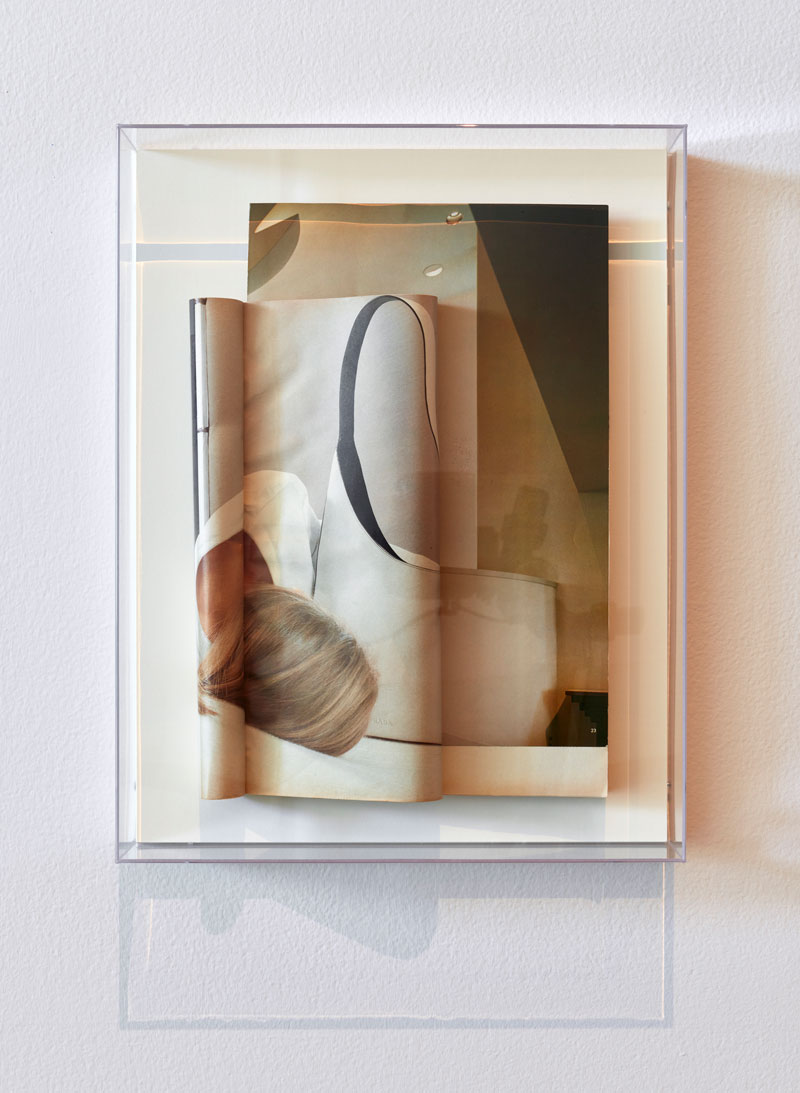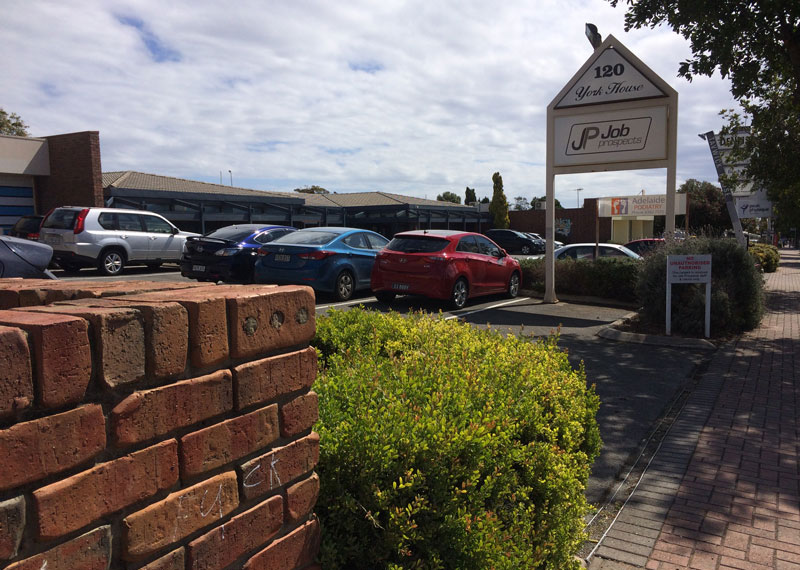
A Telstra Touchfone, that classic landline model once found in many Australian homes, is mounted on the wall outside the entrance to Adelaide’s Samstag Museum of Art. Lifting the handset allows us to eavesdrop on a family’s conversation with Centrelink call centre staff. Listeners might catch a staff member trying to simplify a complex process for the client who, by the sounds of things, is doing the washing up while conducting the conversation via speakerphone, or perhaps they will hear the frustrating strains of Centrelink’s hold music.
Hold Me by Brad Darkson, one of five presentations as part of the 2020 Adelaide//International, explores the architecture of bureaucracy and the way it choreographs our lives. The subject of Darkson’s work is his own experience of addressing a “robo-debt” ascribed to him while working as an artist, sessional university teacher and freelance sole trader. Inverting this private setting into the public sphere, Darkson highlights the divides between the domestic and bureaucratic, between paid and unpaid labour, not to mention class and racial divides. A side-effect of our pandemic world is that social welfare has become a reality for many who never previously believed they would need it. These divides are dissolving and those whose skills were previously valued by the state now find themselves joining Darkson in the ever-lengthening Centrelink queue.
A lot has happened in the world since I visited Samstag during the launch of the Adelaide Festival a few weeks ago. The buzz of those opening events has been replaced by the buzzwords “social isolation” and “social distancing”. Many a meme has been circulated poking fun at the idea: “I’ve been preparing for this my whole life”. But while the World Wide Web provides a way for many to remain connected and continue their employment and other obligations, what of our physical bodies and the way they relate to each other and the spaces around us?
As Samstag Director and Adelaide//International curator Erica Green presciently writes, this year’s iteration of the exhibition “looks to the ways in which built forms can make us aware of the social, spatial and temporal present”. Across five exhibitions-within-an-exhibition, this ranges from the literal built form, to its imagining, reimagining, and dismantling. At the core of the exhibition and of Samstag itself is John Wardle Architect’s work Somewhere Other (2018), a maze-like wooden concertina structure formed in the mind of an architect, informed by the work of an artist and filmmakers, and activated in the spatial and bodily interactions of the audience.
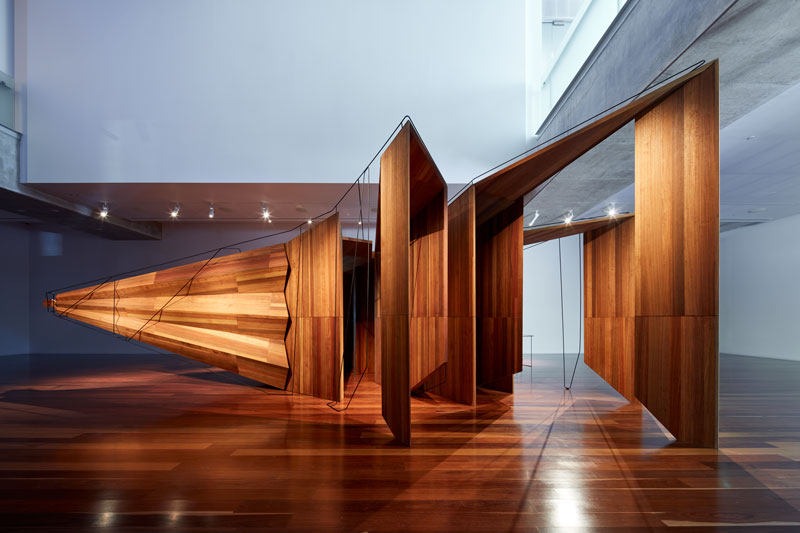
Wardle worked with visual artist Natasha Johns-Messenger to develop and incorporate into Somewhere Other two mirrors which are set at angles within the structure in such a way as to confound the visitor’s sense of trajectory through the space. At least, I think it is two mirrors. The unsettling cleverness of Johns-Messenger and Wardle’s creation is the slippage of boundaries. Is that my shadow, or someone else’s, approaching? Who is around the corner? Where am I headed? The disorientation is offset by the warmth and intimacy of the structure and its materials. The reddish tones of the work’s wooden panelling contributing to a cocooning effect, while a bright red, blown-glass nasal-phallic protrusion at one end punctures the structure, creating a viewfinder containing a mirror which somehow draws in images from outside the gallery door. The external form, characterised by jutting asymmetry, is traced with straight lines of steel which cast zig-zagging shadows over the surface. These lines recall and celebrate the draughtspersonship of architectural practice, the mark of the architect’s hand which is usually long gone by the time their work enters the built environment.
A bespoke flatpack in a world of Allen keys (a seam runs horizontally through its centre), Somewhere Other was originally shown in Venice at the 16th International Architecture Biennale and has journeyed across the seas and been reassembled in Adelaide. Its bellows-like structure and apertures suggest a long lens between Venice and Australia, playing with the motifs of the long-nosed Venetian mask and Ned Kelly’s helmet. At Samstag it can be viewed from above through the atrium of the museum Wardle himself designed. When viewed from this aspect, Somewhere Other appears like a camouflaged creature resting on a leaf, its wooden panelling echoing the floorboards of the gallery. This structure-within-a-structure is experienced as serendipitous but is no doubt a result of Green’s deep familiarity with Wardle’s building.
Somewhere Other suggests it is possible to occupy a contemplative interior state while stickybeaking on the outside world. While this can obviously be understood in the context of contemporary life, particularly under the present circumstances, it also evokes the invention which inspired its form – the camera, by playing with the trickery of lenses, and bringing images from the exterior into its interior. This is also achieved through Coco and Maximilian’s video works, digital portals depicting architectural interiors that sit within an overall structure which is both enclosing and expansive.
Wardle’s work was not conceived as a miniature or fragment of an architecture project, but as an instrument to present an idea about placemaking. Belgian artist David Claerbout also considers placemaking in his work Olympia (The real time disintegration into ruins of the Berlin Olympic stadium over the course of a thousand years) (2016 – ongoing). Hitler’s architect Albert Speer visualised the stadium, built for the 1936 Olympics, as simultaneously a homage to the glory of the Roman empire, and a monument to Nazi ascendancy that would gain gravitas as it crumbled into decrepitude over the following millennium. With the stadium now repurposed, Claerbout takes humans out of the picture, constructing a digital doppelganger which will algorithmically surrender to nature in real time. The human body is in one sense redundant in this scenario – the stadium is left to the forces of nature as flora creeps in and the seasons have their way with the building.
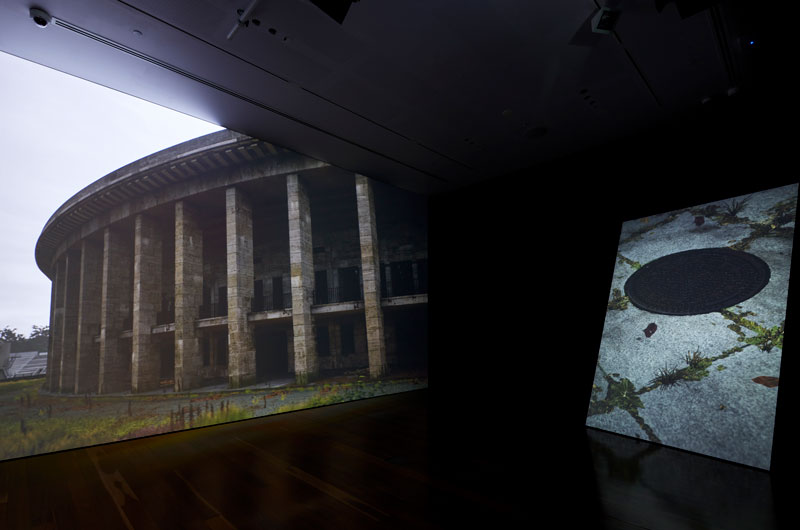
On the other hand, the human body is central to this work – the stadium was built as a monument to the magnificence of human achievement, and its monumental scale was intended to humble the individual. Claerbout’s work is conceived as a 1000-year undertaking, bigger than any of us but with the individual at its core – making, maintaining and viewing it. (The work is guaranteed to continue through Claerbout’s lifetime.) The scaling of his video work, with its two screens, one wall-scale and horizontal, the other vertically presented at a lean, carefully considers the viewer’s body. The larger screen pans around the stadium endlessly at a walking pace. Yet Claerbout’s longitudinal approach to time challenges the fallibilities of the human body in the exhibition space, where attention spans wane.
In Georgia Saxelby’s Lullaby, we also see monumental architecture, this time in direct interaction with the human body. Saxelby’s work is part of Effect in three movements, the only presentation in 2020 Adelaide//International focusing on the work of women practitioners. The exhibition has a distinct tone, representing a softening, a folding, of the traditional structures and strictures dictated through the built environment. (In a sense Johns-Messenger’s mirrors play a similar role in Wardle’s work – folding and reopening the space in new ways and bringing humanity and humour to the serious business of architecture. Wardle professed to being surprised by the often-humorous reception of his work during its Venice presentation.)
In Lullaby, three red-clad figures occupy a neoclassical colonnade, performing individual and synchronised gestures against the soaring columns and endless steps. The two-channel video is projected wall-scale into the corner of a gallery space, the channels’ central seam becoming a point of reflection and inversion for the images. The figures caress the white stone and wring their hands against a backdrop of water. Moving together, the angles of their bodies reflect those of the structure yet contrast with its immovability.
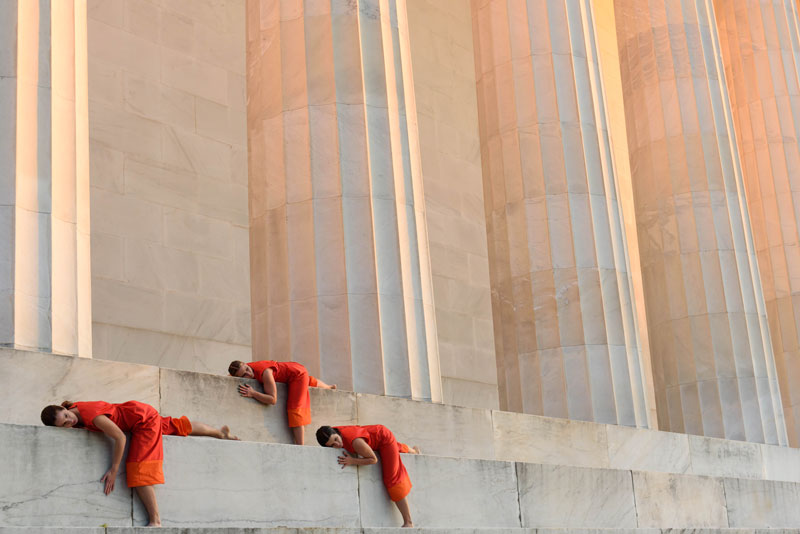
While Saxelby’s video is tucked away in a corner, Helen Grogan’s work ruptures out of the walls and infiltrates other parts of the space with interventions intended to be altered by the artist during the exhibition. Titled SET AND DRIFT (unfolding as 2–4 constellations for/of Samstag Museum of Art, 2020) (2020), Grogan’s work employs the “secondary architecture” of the gallery, exploring and exposing the behind the scenes elements, the fixtures and support structures that are usually invisible to most visitors. Banal video and photographic elements are positioned to draw viewers around the gallery, causing us to follow paths and sightlines we may not have otherwise. This is choreography both deliberate and open to chance.
In Zoë Croggon’s series of sculptural relief works, women’s fashion magazines are folded and collaged to juxtapose and superimpose bodies, objects and spaces. The curve of a jawline drifts into a swathe of fabric; a shoulder morphs into a handbag which switches into a stairwell. Croggon’s works themselves are not entirely fixed – the magazines themselves are left in their rolled or folded state, and it’s discomforting to realise that these women are being bent and folded to fit these material trappings. This slipperiness of humans in the face of architecture can be seen across all the works in Effect in Three Movements, and new gestural relationships are tested.
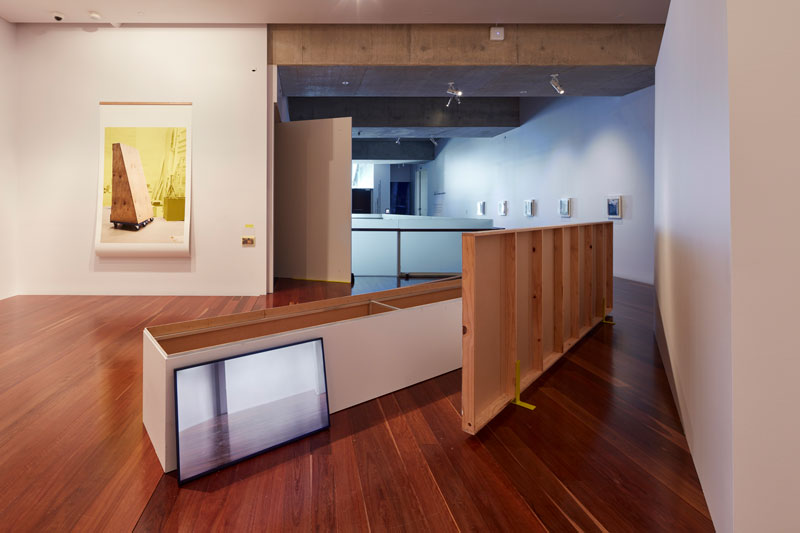
A few doors up in SASA Gallery, artist and architect Matthew Bird’s exhibition Parallaxis centres on a video work depicting two figures crossing a starkly beautiful landscape with large wheel-like objects. Bird employs a coolly seductive sci-fi aesthetic to imagine a futuristic mapping scenario drawing on celestial surveying techniques. The two spacesuit-clad protagonists and their glowing wheels move gracefully and continually, in a paradoxical attempt to pin coordinates through perpetual movement as they cross vast salt lakes and bushland, encountering nineteenth-century architectural ruins along the way. Whilst mapping and surveying are central to humans establishing domestic settlements, Bird shows their unlimited potential when looking to the vastness of outer space.
Museums are always implicated in the choreography of the body through space, and a key element of exhibition-making considers the intellectual and physical narrative that plays out during a visitor’s experience. Of the 2020 Adelaide//International’s five exhibitions-within-an-exhibition, four are solo presentations and one a group show. The exhibitions of Bird and Darkson are located outside the walls of Samstag itself, creating a clear delineation for those projects, while Wardle and Claerbout’s projects and Effect in three movements are located inside Samstag. Wardle’s work sits at the heart of the space, inhabiting the entire of the ground floor gallery and able to be viewed from the first floor where Claerbout, as well as Croggon, Grogan and Saxelby’s work, is found. Depending on whether visitors travel to the first floor via the lift or stairs, they might encounter Claerbout’s work first, or Saxelby’s. The slippage between these elements is inevitable and serves as a reminder of architecture’s active role in the navigating and synthesising of exhibitions.
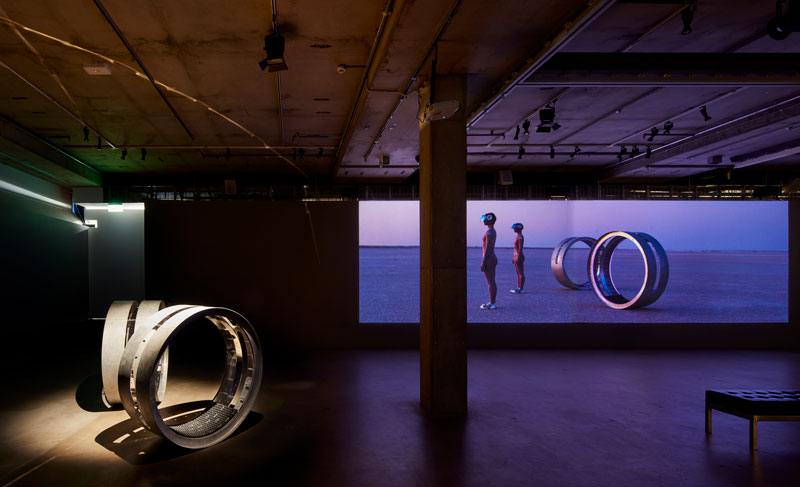
As Green states in her introduction to the catalogue, architecture has an “indispensable role as a ‘choreographer of human experience’”. Temporarily at least this has taken on new meanings. We dance around each other in space, instructed to leave a designated amount of room around our own bodies. Our domestic spaces take on new significance: backyards and front verandahs, balconies, the views from our windows, changing value as other options are denied. For some, a clear separation between home and work has been shattered, as work enters the domestic sphere. For others, the home-office has long been a reality, but it is now occupied by other members of our family. For many including those experiencing homelessness, the closure of public facilities will have a deep impact. COVID-19 has forced humans to re-examine their relationship with architecture.
It has also forced a re-examination of our relationship with time. While we wait for unknown, unspecified weeks and months in isolation, without work, without physical contact with our communities, architecture exists, persists, in the background, supporting, surrounding, interrupting, enduring, collapsing, being propped up. At Samstag, the apertures of Wardle’s organic-geometric structure draw the gaze across an ancient-contemporary timeline; Claerbout’s video piece imagines the present while creating the future; Saxelby, Grogan and Croggon rupture what seemed fixed; Bird’s sci-fi-scape connects us with the universal expanse. And all the while we join Darkson and his family in their kitchen, on hold with Centrelink. This suite of exhibitions serves as a timely reminder of the dance that exists between space and time, and the capacity for architecture to conduct, contain, record and imagine possibilities for the human condition.
